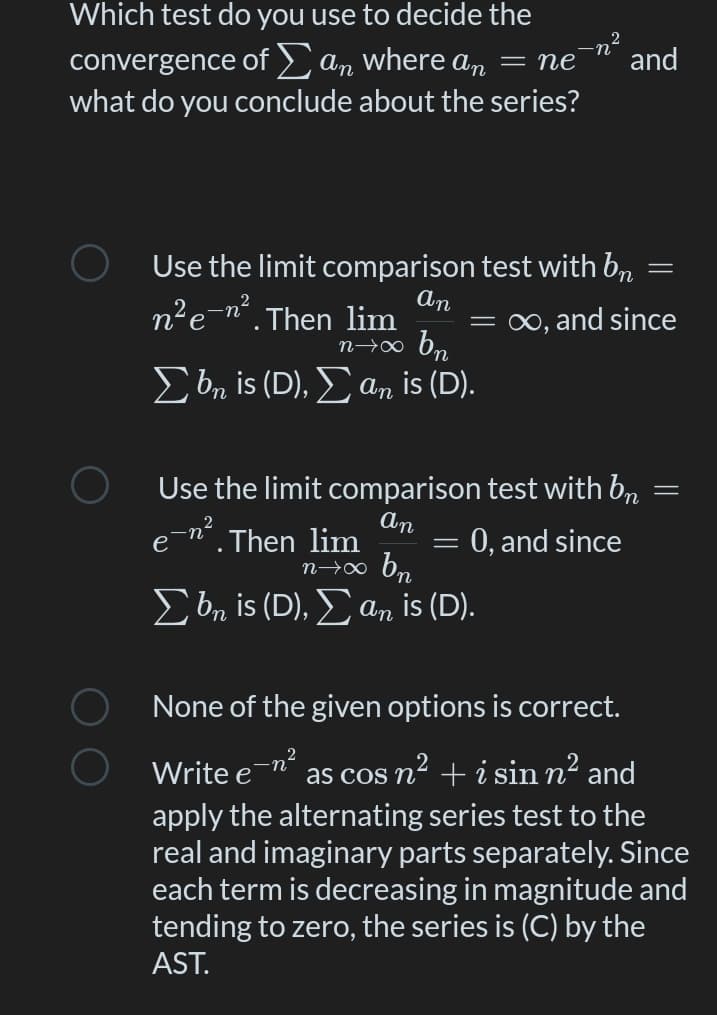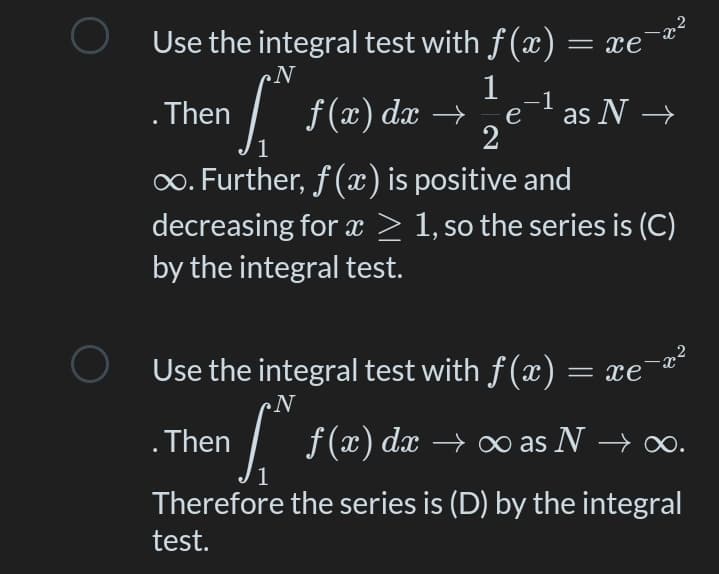Algebra and Trigonometry (6th Edition)
6th Edition
ISBN:9780134463216
Author:Robert F. Blitzer
Publisher:Robert F. Blitzer
ChapterP: Prerequisites: Fundamental Concepts Of Algebra
Section: Chapter Questions
Problem 1MCCP: In Exercises 1-25, simplify the given expression or perform the indicated operation (and simplify,...
Related questions
Question

Transcribed Image Text:Which test do you use to decide the
-n²
convergence of an where an
what do you conclude about the series?
= ne
and
Use the limit comparison test with b,
An
n²e-n°.Then lim
= ∞, and since
n→∞ b,
Σb, is (D), Σ α, is (D).
Use the limit comparison test with bn
An
e-n. Then lim
n→∞ bn
0, and since
Σ, is (D) Σ α, is (D).
None of the given options is correct.
-n²
Write e
as cos n2 + i sin n² and
apply the alternating series test to the
real and imaginary parts separately. Since
each term is decreasing in magnitude and
tending to zero, the series is (C) by the
AST.

Transcribed Image Text:O Use the integral test with f (x) = xe'
N
f(x) dx →
1
-1
e
as N →
.Then
2
1
0. Further, f(x) is positive and
decreasing for x > 1, so the series is (C)
by the integral test.
,2
„x-
Use the integral test with f(x) = xe
¢N
. Then
1/ → ∞ as.
f (x) dx
o as N → o.
Therefore the series is (D) by the integral
test.
Expert Solution
This question has been solved!
Explore an expertly crafted, step-by-step solution for a thorough understanding of key concepts.
Step by step
Solved in 2 steps

Knowledge Booster
Learn more about
Need a deep-dive on the concept behind this application? Look no further. Learn more about this topic, algebra and related others by exploring similar questions and additional content below.Recommended textbooks for you

Algebra and Trigonometry (6th Edition)
Algebra
ISBN:
9780134463216
Author:
Robert F. Blitzer
Publisher:
PEARSON

Contemporary Abstract Algebra
Algebra
ISBN:
9781305657960
Author:
Joseph Gallian
Publisher:
Cengage Learning

Linear Algebra: A Modern Introduction
Algebra
ISBN:
9781285463247
Author:
David Poole
Publisher:
Cengage Learning

Algebra and Trigonometry (6th Edition)
Algebra
ISBN:
9780134463216
Author:
Robert F. Blitzer
Publisher:
PEARSON

Contemporary Abstract Algebra
Algebra
ISBN:
9781305657960
Author:
Joseph Gallian
Publisher:
Cengage Learning

Linear Algebra: A Modern Introduction
Algebra
ISBN:
9781285463247
Author:
David Poole
Publisher:
Cengage Learning

Algebra And Trigonometry (11th Edition)
Algebra
ISBN:
9780135163078
Author:
Michael Sullivan
Publisher:
PEARSON

Introduction to Linear Algebra, Fifth Edition
Algebra
ISBN:
9780980232776
Author:
Gilbert Strang
Publisher:
Wellesley-Cambridge Press

College Algebra (Collegiate Math)
Algebra
ISBN:
9780077836344
Author:
Julie Miller, Donna Gerken
Publisher:
McGraw-Hill Education